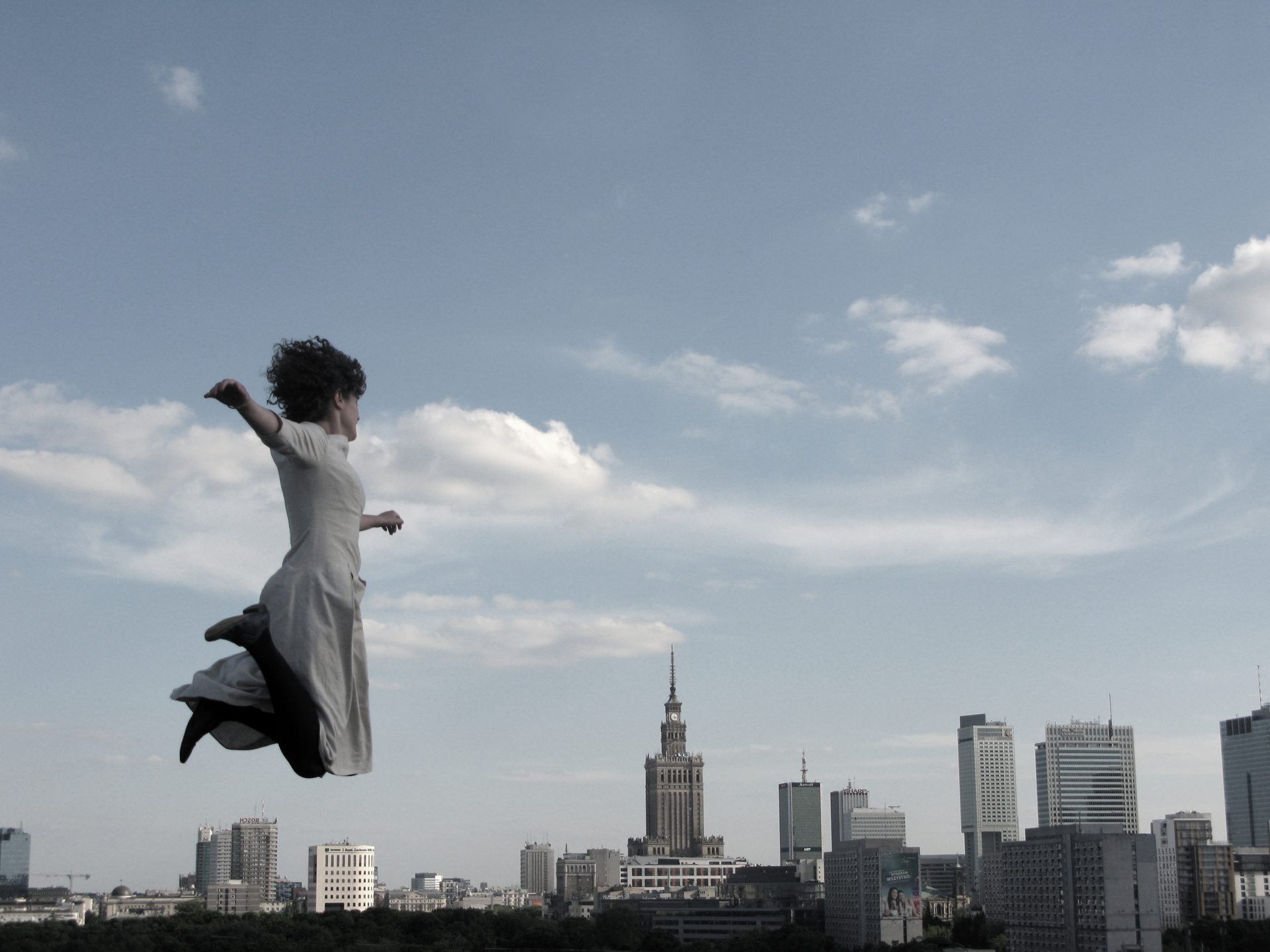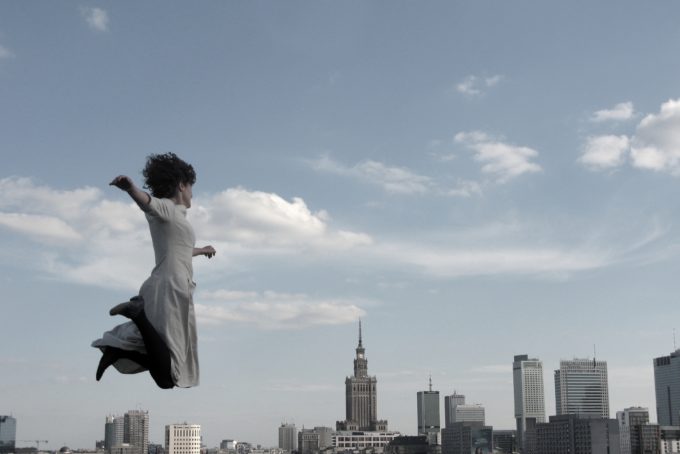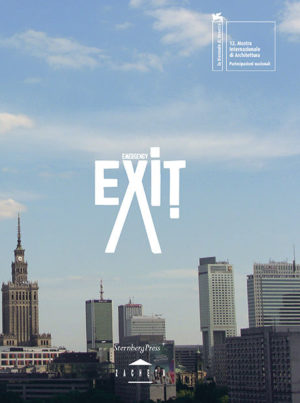
Emergency Exit
‘A neon Emergency Exit sign hangs on the facade of the Polish Pavilion. Inside, a surreal structure made of hundreds of reclaimed bird cages hides a path to its summit. It is lit from within, suggesting a night landscape, a fantastical de-materialized world containing an object and an action. You climb the seemingly precarious structure. At the height of the summit you look down into a churning sea of clouds. Your breath catches, your pulse quickens; you look down, then out, and then leap blindly into the void. . .’
The installation Emergency Exit by artist Agnieszka Kurant and architect Aleksandra Wasilkowska seeks to go beyond the logic of urban reality through the creation of ‘urban portable holes’: in-between spaces, places of uncertainty and doubt, of time-space discontinuity, such as abandoned or unfinished buildings, sites of catastrophe or accidents, illegal markets, rooftops and tunnels. The title refers ironically to the health and safety regulations in buildings and urban space that seek to plan, control risk and eliminate the accidental and unexpected.
The installation is constructed from an aggregate of metal cages, more commonly used to contain birds and prevent flight, to create a new fictional sport within the urban context. The design makes reference to the forms of decaying sports monuments, such as the ski jump in Mokotów, Warsaw—a surrealistic icon of socialist era architecture that is now in ruins. During a test phase, visitors were able to climb to the top of the structure and jump out into artificially generated clouds, representing ultimate freedom and urban escapism. These actions were documented and are now presented within the Pavilion.
Kurant and Wasilkowska interpret the city as an unpredictable, complex system whose collective understanding is composed of intersecting real and imaginary spaces changed through extremely rare events. Nine out of ten things that influence our behaviour and thinking are invisible or intangible. Factors such as myths, rumours and legends overlay themselves onto the physical environment to create an urban morphology of augmented landscapes. At the same time, spontaneity and risk exist as human characteristics that can work against a rational layer of control within the urban fabric. Both invisible phenomena and social actions can change the dynamic of a street, borough, or even the entire city. Architects and planners are therefore unable to precisely anticipate all the needs and transformations of the city. If a rigid and deterministic master plan is unable to integrate emergent needs and changes then the whole city looses its equilibrium.
Emergency Exit is conceived as a hybrid machine for the transfer to other realities, perforating the system of the city. It is a portable hole to the unknown; a catalyst for different, contradictory emotions and needs. Through the transfer, people fill in the gaps with their own emotions, ideas and desires. Kurant and Wasilkowska see the moment of jumping as an exit from the modernist paradigm in architecture where emotional, affective space was ignored and considered an obsolete ornament. The activity materialises the need and desire to lose control, to free oneself both physically and metaphorically from the current system; from a dominant paradigm, logic or state. To get out of here
The project promotes an approach to architecture and urbanism that reverses the logic of a unilaterally defined urban reality and deterministic master plan; it embraces the unknown phenomena of the city; introduces a higher flexibility of the urban tissue through integrating interstices, gaps and pores, and leaving people space to plug-in or plug-out of dominant urban structures through developing individual, self-organising activities and actions.
- YEAR2010
- CATEGORY Biennale Architettura
- EDITION12
- DATES28.08 – 21.11
- COMMISSIONERAgnieszka Morawińska
- CURATORElias Redstone
The Authors. Biography
Artists:
Agnieszka Kurant (1978) is an artist based in Warsaw. She holds an MA in Art History from the University of Łódź and an MA in Creative Curating from Goldsmiths College, London. She often collaborates with scientists and professionals whose activities are considered to be fictitious or paranormal to investigate phenomena that exceed the logic of time, space, language and knowledge. She explores the economy and politics of invisibility and the existence of the future in the present. Her works have been shown in art institutions including: Palais de Tokyo, Paris; Tate Modern, London; Yvon Lambert Gallery and Creative Time, New York; and Museum of Modern Art, Zachęta National Gallery of Art, Centre for Contemporary Art Ujazdowski Castle, Warsaw. She has also produced work in public space, (…) with Anna Baumgart (2009). Kurant has participated in international contemporary art exhibitions including: Moscow Biennale (2007), Bucharest Biennale (2008), Frieze Projects at Frieze Art Fair, London (2008), Performa Biennial, New York (2009), and Athens Biennale (2009). She has received numerous grants and awards and was an artist in residence at Palais de Tokyo, Paris in 2004; ISCP, New York in 2005; Konstfak, Stockholm in 2007 and at the Paul Klee Center in Bern, 2009. Kurant’s monograph Unknown Unknown was published by Sternberg Press in 2008.
Aleksandra Wasilkowska (1978) established a studio in Warsaw in 2007 for spatial and social research and practice after studying architecture at the Warsaw University of Technology and École d’Architecture de Bretagne. She has collaborated on projects with artists, sociologists, scientists, and mathematicians to explore the territories between architecture, art and science. Projects investigating new urban strategies and modes of collective production in public space have included: Symbiotic City (2005), MultipliCity Disorder (2008), Warsaw as Emergent Structure: Em_Wwa 1.0 (2009), and Assembling in Public (2010). Wasilkowska has participated in exhibitions including Warsaw under Construction at Museum of Modern Art, Warsaw (2009); Expectation in Bęc Zmiana Foundation, Warsaw (2009); Extremely Rare Events in Centre for Contemporary Art Ujazdowski Castle, Warsaw (2009); and The Witch is Watching at the Institute of the Avant-garde, Warsaw (2010). Completed projects include [No.Platform] at the Zachęta National Gallery of Art, Warsaw; and a temporary structure for the Chelsea College of Art and Design, London (2010). Warsaw as Emergent Structure was published by Bęc Zmiana Foundation in 2009. A self-sufficient house in Warsaw and an installation in Wigry are currently under construction.
Curator:
Elias Redstone (1979) lives in London and holds an MSc in City Design & Social Science from the London School of Economics. He was Senior Curator at The Architecture Foundation, a non-profit agency for contemporary architecture, urbanism and culture, where he worked from 2003 to 2010. He initiated an innovative and experimental curatorial programme working with architects, artists, designers, photographers and filmmakers. Exhibitions include Hairywood (2005), I Shot Norman Foster (2005), Renegade City (2006), Southwark Lido (2008), Temporary Eyesore (2008) and Moss Your City (2010). He has curated projects for the 10th International Architecture Exhibition in Venice (in collaboration with MoMA, New York) and the London Festival of Architecture. He launched an international exchange programme for emerging architects in the UK and abroad (working with USA, Italy, Norway and Poland to date) and has delivered numerous collaborative projects with cultural institutions, such as the Barbican, Southbank Centre, Tate Modern, Victoria & Albert Museum, Design Museum and British Council. He is the co-founder and editor of the “London Architecture Diary” and is a columnist for the “New York Times” design blog. Redstone received a D&AD Global Design Award in 2006 and a Winston Churchill Fellowship in 2008.



